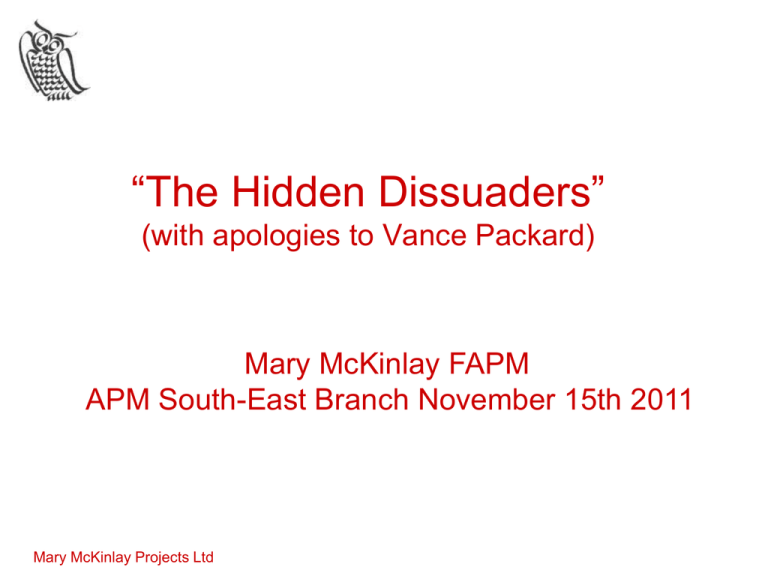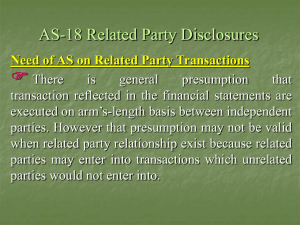Company Presentation - Association for Project Management
advertisement

“The Hidden Dissuaders” (with apologies to Vance Packard) Mary McKinlay FAPM APM South-East Branch November 15th 2011 Mary McKinlay Projects Ltd Vance Packard – Who? American 1914 – 1996 In 1957 published “The Hidden Persuaders” Book about advertising techniques – often covert Gave examples of their use in politics Opened public eyes to what he called our “hidden needs” Mary McKinlay Projects Ltd The Hidden Dissuaders? Otherwise known as STAKEHOLDERS Who? What? Where? When? How? Mary McKinlay Projects Ltd Who Am I? Managing Director Mary McKinlay Projects Ltd Adjunct Professor of PM at SKEMA Teaching Fellow Middlesex University 30+ Years in Aerospace and Defence Business Degree in Systems Engineering Worked on Lifecycle Management and Project Management Methodology “Problem” Project work Member of APM Board Member of ICCPM Board Mary McKinlay Projects Ltd Agenda Introduction Identifying and Understanding Stakeholders Balancing their needs Defining Project Success Mary McKinlay Projects Ltd What is a Project? “A Project Is A Unique Transient Endeavour Undertaken To Achieve A Desired Outcome” (APM Body of Knowledge v5) Projects can be of any kind All Projects result in change What about Programmes? And Portfolios? Mary McKinlay Projects Ltd Projects Have defined scope/deliverables – WHAT? Are time bounded – WHEN? • Have clearly defined start and finish Have an element of uniqueness Are usually multidisciplinary • Involve integration Require specialist management techniques Have single-point responsibility (the PM) Have a strong implementation bias Contain risk Mary McKinlay Projects Ltd The “Iron” Triangle TIME SCOPE COST Mary McKinlay Projects Ltd QUALITY The Change Management Iceberg C T Q/S Pr PP P&B Ho Op P&P Negative Positive Under the surface – Management of perceptions and beliefs Management of power and politics Mary McKinlay Projects Ltd Who are the Stakeholders? “Any person or group who may affect or be affected by the project” Mary McKinlay Projects Ltd Project Stakeholders Customer Project Sponsor User Project Team Members Suppliers Subcontractors Service Departments/Functions Senior Management Shareholders Society Local Communities Government ??????? Mary McKinlay Projects Ltd Systems View of a Project Primary Stakeholders within the system Secondary Stakeholders Secondary Stakeholders Primary Stakeholders Secondary Stakeholders in the Environment • They are not part of the system but can affect it Mary McKinlay Projects Ltd Secondary Stakeholders Primary Stakeholders Some examples Project Manager Customer Project Team Suppliers and Sub-Contractors Company and Management Shareholders End Users??? may affect the project directly Mary McKinlay Projects Ltd Questions to be answered Project Manager Why are you doing this job? What do you want as your outcome? Project Team What does the team want? Are there issues on development and careers? Company and Management Why is the Company taking on this job? Is it Strategic? What is the desired outcome? Margin? Further work? Shareholders Is increase in Shareholder value the main issue? Mary McKinlay Projects Ltd More Questions Customer Suppliers and Sub-Contractors End Users Mary McKinlay Projects Ltd Why are you undertaking this project? What is the most important element of the job? Key requirement? Is the project sensitive to cost/time/quality issues…….???? Why have they accepted the job? How important is it to them? Who are they? Do they have the same view as the Customer? What are their expectations? Secondary Stakeholders Government Bodies Political Groups / Pressure Groups National and International influences Local people • Affected by development • Related to employees Project Management should seek to understand the potential impact both on them and the project Mary McKinlay Projects Ltd Stakeholder Matrix B – High Interest / Importance, Low Influence A – High Interest / Importance, High Influence They will require special initiatives if their interests are to be protected They are the basis for an effective coalition of support for the project D – Low Interest / Importance, Low Influence C – Low Interest / Importance, High Influence Stakeholders are of less importance to the project, but monitoring of their influence must be maintained. Stakeholders can influence the outcomes of the project, but their priorities are not those of the project. They may be a risk or obstacle to the project Mary McKinlay Projects Ltd Force Field Analysis Kurt Lewin Driving NO CHANGE Mary McKinlay Projects Ltd Restraining CHANGE Defining Project Objectives Formal Sources • Requirement Specification • Contract • Plan IS THIS ENOUGH? Mary McKinlay Projects Ltd Project Objectives Formal Sources • Requirement Specification • Contract • Plan PLUS……. • • • • • Identification of Stakeholders Understanding needs Asking questions Recording results …….. Mary McKinlay Projects Ltd “The Beholders” Stakeholders – Their Objectives HARD OBJECTIVES usually (but not always) documented SOFT OBJECTIVES rarely documented often not even articulated Examples: Contract stakeholders soft Scope of work objectives may Work Package Description conflict Mission Statement often change during Policy Document White Paper project For projects to be perceived a success, we must know these objectives, and meet as many as possible Mary McKinlay Projects Ltd Critical Success Factors …those (measurable) factors, that, when present in the project’s environment, are most conducive to the achievement of a successful project (APM BoK) Key Performance Indicators Are project management indicators that are determined at project start and reflect directly on the key objectives of the project (APM BoK) Mary McKinlay Projects Ltd The Project The Critical Success Factor on any project is Understanding the Stakeholders needs and delivering the right balance Stakeholder Analysis should be undertaken at Project Inception With this understanding Critical Success Criteria can be defined • This will enable the success of the project to be judged at the end • These should be recorded and retained with all other project information Key Performance Indicators can be derived from the Critical Success Criteria and they are used to monitor progress. Mary McKinlay Projects Ltd More uses of Critical Success Criteria Risk Assessment • If you know what success looks like – it is easier to assess threats • Risk can be better focussed, more realistic Assign Priorities Help to the Project Manager to understand and predict behaviour Definition of Key Performance Indicators – help to monitor project Mary McKinlay Projects Ltd The vital links…………. identify (key) stakeholders identify stakeholder objectives/expectations define project objectives identify critical success factors identify & analyse risks define key performance indicators Mary McKinlay Projects Ltd quote from Sir John Harvey-Jones: "Planning is an unnatural process - it's much more fun to get on with it. The real benefit of not planning is that failure comes as a complete surprise and is not preceded by months of worry" Mary McKinlay Projects Ltd Project Manager Roles Accountant Business Man Diplomat MIND READER Social Worker Magician Mentor Coach Mary McKinlay Projects Ltd Success? Is in the eye of the beholder? Mary McKinlay Projects Ltd Project Management Mary McKinlay Projects Ltd









